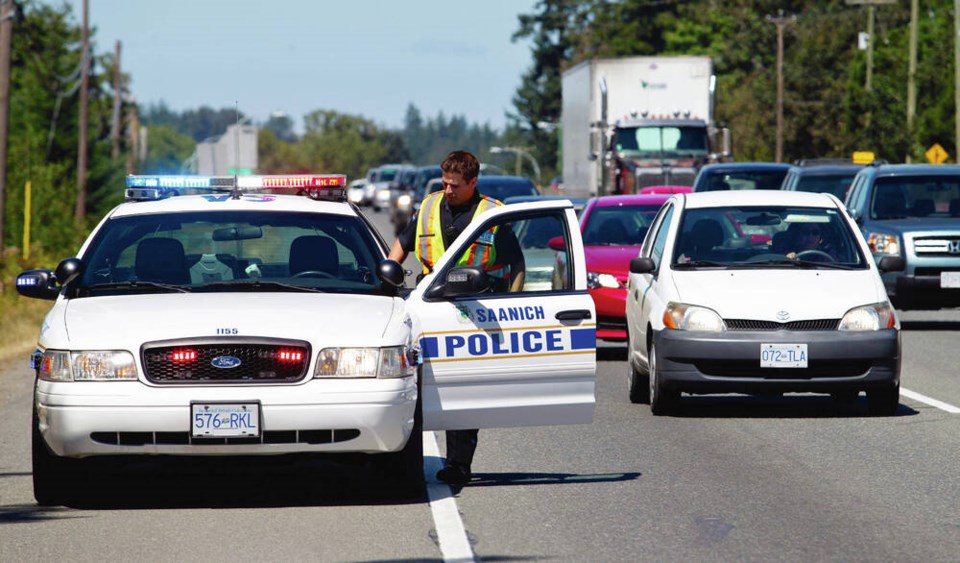As part of their duty to keep citizens safe, governments regularly launch road safety campaigns throughout the year. These campaigns also push out information and education efforts — multimedia splashes with clever pithy slogans, puns and metaphors that can’t help but grab our attention.
Some of my favourites over the years have been: “Fools rush in,” accompanied by an image of a traffic light or intersection; “You are not a pumpkin. Don’t drive smashed,” obviously aimed at impaired driving, or how about: “Get your head out of your apps,” an awesome contemporary harbinger about the dangers of distracted driving via electronic devices.
For readers who continually express frustration about traffic habits on the Pat Bay highway, I found an ad from the U.S. that reads: “Hey. Camp in state parks. Not in the left lane.”
On the more dramatic side, one ad shows an adult leading a string of young children across a road in front of a yellow school bus. The road, though, has transformed into a seemingly bottomless canyon and they must cross it via a very precarious looking rope bridge tied to the front of the bus. The caption reads: “It shouldn’t be this dangerous.”
You’d think that these types of bright, forceful and memorable ads would have big impacts on bad driving behaviour.
The sad news is they rarely have any. In some cases bad driving behaviour actually increases during periods of high-profile traffic safety ad campaigns.
How so?
Well for one, PR campaigns are simply reframing safety messages we’ve heard a hundred times before — and generally ignore.
Next, PR campaigns target the individual — implying they alone can fix road safety. It’s a premise that believes that the right messaging will eventually create that “aha” moment in a driver, leading forever to flawless driving behaviour.
But this psychology also allows us to blame the other individual — “that other guy” — for all of our road safety problems.
“I drive perfectly, but that other ‘nut job’ behind the wheel doesn’t have a clue.”
Let’s look at it practically.
If you think about it, what has actually saved more lives on our highways — a year of witty PR slogans or laws requiring automobiles to have airbags? Or how about placing a concrete divider down the middle of a busy freeway?
So what else actually works?
Several big studies in North America and Europe show that practical, straightforward efforts, including roadway re-engineering, have way more effect on saving lives than do ad campaigns.
They include things like: Police road checks for impaired driving and ongoing alcohol assessment and treatment for bad drivers (both rated as “5-star” measures by the U.S. traffic analysts to prevent road injuries and deaths) and strict use of child restraints — calculated to have lowered auto related child injuries and deaths by 70 per cent.
There is a place for well-thought-out targeted advertising campaigns that operate directly with enforcement efforts or changes to driving laws — such as the adoption of child safety restraints.
In Australia, seatbelt use was calculated at 18 per cent to 26 per cent prior to enactment of restraint laws. After those laws were passed and then coupled with advertising campaigns informing drivers of those new rules, urban seatbelt compliance rose to 75 per cent.
We’re in tough economic times already and every dollar counts.
Reams of evidence show us that our money is better spent straightening a dangerous “killer” curve or targeting repeat offenders with stricter sanctions, rather than slick, witty and mostly ineffective PR projects.
Glove Box: Howard wrote in last week after an argument with a friend about stop sign rules. The friend claims that if three cars, one behind each other, pull up to a stop sign only the first car in that line needs to stop — the others are permitted to follow on without stopping.
Unfortunately for Howard’s friend, that’s false.
Section 186 of B.C.’s Motor Vehicle Act lays out pretty clearly where and how you must stop at a stop sign:
1) You must stop at a marked stop line, if there is one.
2) If there’s no stop line, then you must stop at the first crosswalk line on the near side of the intersection.
3) If there’s no stop line or crosswalk, then you must stop at a point where you have a view of approaching traffic from the intersecting street.
It’s also important to remember that stop means “a complete cessation of movement.”
Finally, the act requires that after you have stopped, you must enter the intersecting highway safely and yield to any cross traffic until it’s clear to proceed.
Failing to yield after stopping is a major cause of collisions and just as dangerous as running through that stop sign in the first place.



